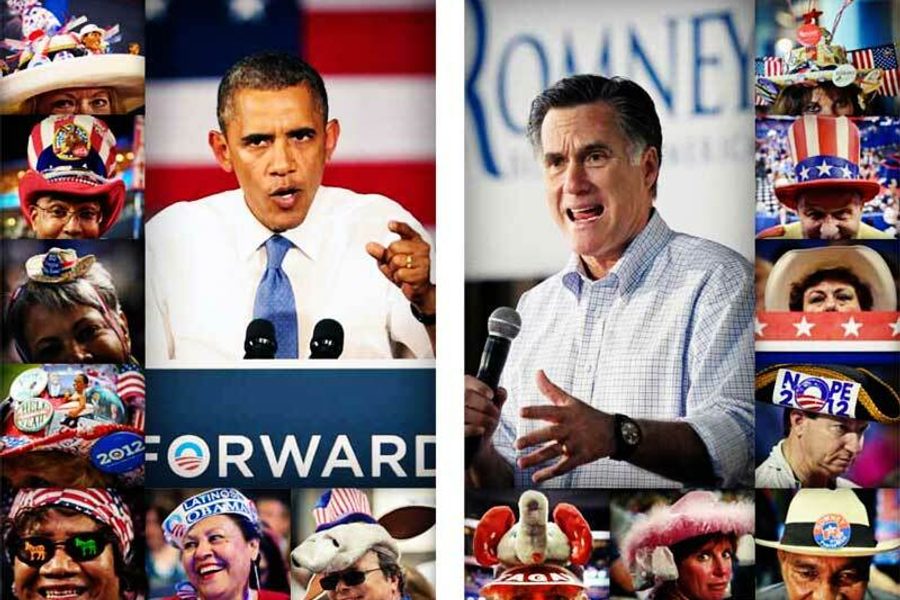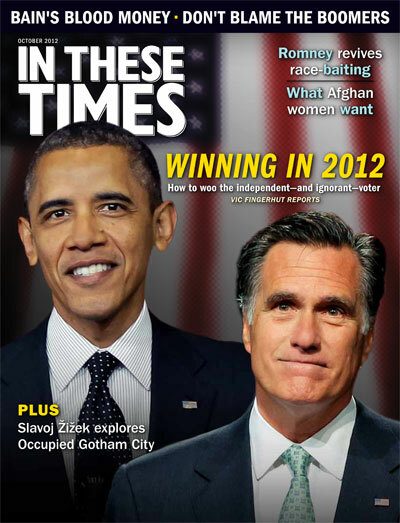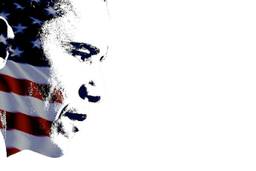Winning in 2012
Wooing the volatile, mistrustful, anti-political — but crucial — Independent vote
Vic Fingerhut

A deluge of “battleground” state polls reporting neck-and-neck heats between President Obama and Republican Mitt Romney has emerged in the past two months, setting off a wave of political commentary. That talk has focused primarily on such items as the short-term fluctuations in the economy, the impact of massive spending by Super PACs, Bain Capital and Romney’s offshore bank accounts, and the various gaffes of the respective campaigns.
Lost in this discussion, however, has been the central fact that long before Mitt Romney wrapped up the GOP presidential nomination and despite the monthly upticks or downticks in the economy — particularly the unemployment rate — the fundamental parameters for a close 2012 presidential election had already been set.
Clearly the most important — and surprisingly, the almost universally ignored — factor in this regard has been the loss of the Democratic Party’s 7-point advantage in party identification since the last presidential election — the exact margin of Obama’s victory over John McCain in 2008.
According to the latest readings of party identification, the number of self-identified Democrats and Republicans in America is now roughly equal, with some surveys actually showing a slight GOP advantage among likely voters.
This was not a sudden development of the post-GOP nominating struggle. The slippage in the Democrats’ party-identification advantage began in the fall of 2009 and continued throughout much of 2010 and into 2011.
While shifts in party identification are the most important movements in American electoral politics, they are also the most subtle. It is not easy to pin down the causes of this movement away from the party of FDR and JFK. As I wrote in the February 2010 issue of In These Times, in the final months of 2009, the evening news regularly juxtaposed stories of high levels of joblessness in America’s industrial heartlands (and elsewhere) with record profits for Wall Street — profits that were stoked by the bank bailouts that Obama and most Democrats uncritically supported. The public perceived, fairly or not, that the Obama administration had failed to adequately address the devastating jobs situation. Consequently, the image of the Democrats as the “party of ordinary working American families” began to erode. This perception of the party as the defender of working people had been its greatest source of electoral strength for more than 70 years — and the single most frequently volunteered reason for Democratic Party identification.
Since party identification shifts in America occur glacially — generally no more than 2 to 3 points a year, at most — we can be reasonably certain that when Americans go to the polls this November, the electorate will be very evenly divided between self-identified Democrats and Republicans.
But how much does this new 2012 distribution of “party identification” really mean when it comes to Americans actually casting their ballots?
The answer is a lot. Indeed, probably more than any other single factor.
Despite all the commentary during the primary period about how one or another of the contenders for the Republican nomination would be unacceptable to this or that wing of the party, Republican candidates for president (whoever they were) have — for the past 60 years — averaged more than 90 percent of the vote of self-identified Republicans.
As a long-time Democratic consultant, I have attended more presidential strategy sessions than I care to remember in which Democratic strategists constructed elaborate (and ultimately fruitless) plans to siphon off the votes of some (imaginary) cache of “moderate” Republican crossover voters. With the exception of the polarizing campaign of Barry Goldwater in 1964, all of these plans and stratagems failed miserably — and even Goldwater got 80 percent of the GOP vote.
Recent polls showing Romney with more than 90 percent support among Republicans should disabuse Democratic strategists of the notion that there is much room to peel away GOP voters from their 2012 nominee.
Conversely, looking at presidential elections for the past 60 years, we can confidently predict that the Democrats will get between 5 and 8 percent of the votes of self-identified Republicans — whatever they do.
If the Democrats do have an identifiable group of voters who are historically susceptible to GOP appeals, it is white, lower- and middle-income working people, a group that has been historically drawn to the Democratic Party, not because of its liberal social policies, but because the Democratic Party is, as Harry Truman put it, “the people’s party.”
Independents’ day
The critical bottom line, then, of this loss in Democratic partisan advantage is that the fight for the presidency will now center almost exclusively on political Independents. And here neither political party enters the field with a decided advantage.
Is this, one might ask, anything different from past elections?
The answer is yes.
Take, for example, the election of 1960, in which, despite all the talk about John F. Kennedy’s “charisma,” Nixon actually defeated Kennedy handily among Independents — by 14 points, 57 to 43 percent. Nixon also got twice as many Democratic defectors (10 percent) as JFK got GOP defectors (5 percent). So how then did Kennedy manage to win? The answer, as Nixon — a shrewd analyst as well as practitioner of American politics — sadly understood, was not Kennedy’s “charisma” but the Democratic advantage in party identification, which was well over 10 points at the time.
In contrast, the current parity in party identification means that — unlike Kennedy — President Obama will have to capture a plurality of self-identified Independents to assure victory.
Interestingly, while there are several sub-segments of Independents, they are not united by any single demographic. What unites them is a distinct set of underlying attitudes toward politics and political parties.
There is a prevailing myth in American politics (often served up in junior high school civics textbooks and advanced by the media) that portrays Independents as highly informed and dispassionate voters who wait until all the arguments are made before they make their carefully considered electoral decisions. Some self-identified Independents do fit this textbook image, but for decades surveys have shown that Independents are the least interested and least informed segment of the electorate.
That reality makes their perceptions (and vote choice) highly susceptible to very modest inputs of new information, which accounts for their extremely high volatility in the polls. From now until Election Day, as Democrats and Republicans stabilize their presidential support levels in the 88 to 94 percent range, almost all movement in the polls will come from Independents.
Power to the people
There are, however, other important characteristics of political Independents. As a group, they tend to harbor deep anti-institutional suspicions. This is one of the reasons they are not tied to any political party. And this suspicion extends beyond political parties: to government in general, labor unions, corporations, and — for some white Independents — to minorities and immigrants.
A large segment of them are socially and fiscally conservative, but also economically populist, making them very susceptible to populist campaigns and messages — from both the Left and the Right.
Indeed, the two most identifiably populist presidential candidates of the past half century, former Alabama Gov. George Wallace and Ross Perot, drew their highest levels of support from self-identified Independent voters. Each candidacy had both Left and Right aspects. As conservatives and fellow business leaders wanted, Perot was a staunch supporter of a balanced federal budget, but he also favored using the federal government’s powers aggressively to balance the trade deficit — a major demand of the labor movement. Fortunately for the centrist, free-trading Democratic presidential candidate Bill Clinton, Perot’s media advisers focused their TV campaign on the budget — rather than the trade deficit — thus stealing Independent votes from the Republican incumbent George H. W. Bush. This enabled Clinton to squeeze out an electoral victory with 43 percent of the vote — 3 points less than Dukakis.
And when several million of Wallace’s largely segregationist supporters left him in the final days of the 1968 presidential campaign, they were responding to the economic populist appeals of perhaps the most outspoken proponent of civil rights among 20thcentury American political leaders, Hubert Humphrey.
As a result, barring some major extraneous event (a war, a sharp economic downturn), and given the critical role of the volatile Independent vote, the 2012 election is likely to be determined by whether a rightwing or leftwing populism dominates the national dialogue in the final weeks of the 2012 campaign. In short, rather than the rush to the “center” so often urged by political pundits, the outcome in 2012 will depend on which competing populist vision will connect with the highly skeptical, ideologically schizophrenic, but absolutely critical pool of self-identified Independent voters.
Back to the future
What, then, is the possibility that in the next few weeks a Democratic populism will defeat the GOP mix of (supposed) managerial competence, and attacks on welfare and public employee unions? In the past, the Democratic advantage, both in party identification and the underlying perception that the Democrats represented ordinary folks, was often able to override these GOP messages when invoked early enough in the campaign. However, theswitch to an economic populist stance was either invoked too late in the campaign to overcome the preexisting GOP lead (Humphrey 1968 or Dukakis 1988) or was abandoned too soon in the mistaken belief that a successful populist message at the convention had served its purpose to “rally the base” and the post-convention campaign required a move to the center (Gore 2000). One would hope that the failed Gore campaign strategy is not repeated in 2012.
This year, the Democrats did launch a populist campaign early on. Indeed, with Romney as the GOP standardbearer, it would be nearly impossible for any Democratic campaign not to see the populist possibilities. Not just is Romney rich, but his offshore banking, his outsourcing of American jobs (via Bain Capital) and his low net tax rate make him almost a perfect symbol — or caricature — of what self-identified Independents and other swing voters have always indicated quite clearly in polls that they like least about the Republicans: that they favor the very rich and big corporations and don’t understand the needs of ordinary working people. However, it is clear from polling that as of early September, $400 million in spending on the part of the official Obama campaign and its supporting super PACs has had little or no appreciable impact on the critical Independent vote.
Successful political campaigns involve more than choosing the right overall frame. They also entail finding the correct symbols and vehicles for reaching the Independent swing voters who, as noted, are elusive and distrust not only politics, but political communications.
TV spots like those the campaign has been running, that begin with shots of President Obama walking around the White House or that are underlined with newspaper quotes running along the bottom of the screen, have “politics” written all over them. Such ads are bound to be an immediate turnoff for the anti-political crowd of Independents, who must be approached in more subtle ways.
Fights over conflicting images and frames are much more likely to move in your favor in the final days of a campaign when those images and frames have been embedded on your side in the past.
Thus, if presented correctly, Romney and Paul Ryan’s plans to reshape (destroy) JFK’s program of Medicare (in the interests of the big insurance companies) must be linked — in a populist way — closely and vividly to the GOP’s historic opposition to JFK’s original Medicare proposals. Right now the debate revolves around an evaluation of the relative credibility of Romney or Obama in the present. But when the past is thrown in, the GOP loses. For example, TV spots containing a brief summation of the summary vote count on Medicare — by party — will trigger the remembrance among Independents older than 65 that the Republicans opposed Medicare (and Social Security) from day one. In this way the currently not insubstantial Romney margin among senior voters could be reduced or even reversed.
Similarly, pitting ordinary folks against the big financial institutions, the major health insurers, and the firms that use tax breaks to help finance the outsourcing of American jobs, is a matchup that has deep roots in the American psyche (not to mention a strong historic pro-Democratic valence).
It is also relevant to point out that no matter how much the GOP and its flush Super PAC affiliates spend, the Democrats and their supporting Super PACs have more than adequate funds to at least present their case to this critical group of swing voters. There may also be some reason to believe the GOP’s massive spending may be approaching a level of diminishing, if not negative returns, particularly among anti-political Independents.
I have tried to suggest where the final battle lines will be drawn for 2012 — and what this implies for reelecting Obama — but it is equally important to make a few final observations about how this discussion relates to the longer-term future of American politics.
First, as party identification remains the single most important factor in voting choice for an overwhelming portion of the American electorate, it is clear that, win or lose in 2012, the Democrats — indeed, all progressives, whether in the labor or the environmental or women’s or civil rights movements — must make it a top priority to identify and implement a strategy to increase Democratic Party identification. Never again must concern about GOP attacks about the size of the deficit (they will come whatever the Democrats do) undermine in any way Democratic efforts to fight joblessness and promote the economic well-being of American working families.
The Democrats must recognize that their strength as a party overall, as well as their appeal to Independent voters, resides primarily in its “representational character” — that is, in its image as representing the fundamental economic concerns of regular American working- and middle-class families.
And this is critical. It is the weakening of this perception over the past three years — with its resultant loss in the Democrats’ once-massive party identification advantage — that has turned not only the contest for the presidency but the fight for control of Congress into a neck-and-neck horse race.
Fortunately for Democrats, both the choice of the Republican nominees and their adherence to a clearly antiworking-family agenda — whether it be threatening grandma’s, mom’s or your own Medicare by turning it into a voucher program, or continuing to support tax breaks for the very wealthy — has provided the Democrats with an opportunity to hold onto the White House in 2012.
And should the Democrats succeed, then the very closeness of the 2012 election resulting from the loss of their historic advantage in party identification should serve both as a warning signal and a clear guideline for the actions of the next Obama administration.








